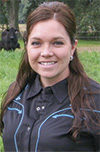Forage-based livestock systems require year-round forage programs to provide sufficient nutrients to meet the cattle nutrient requirement. The first question we need to ask is, “What are the target weight gains we are expecting the animals to have along the year?” This answer will vary depending on the class of livestock – including cow-calf systems, backgrounding, developing heifers or even finishing. Each class has a different requirement, even along the phases.
For example, in the cow-calf system, we have times when the nutrient requirement is greater. Lactating cows have higher nutrient requirements than brood cows at the end of their lactating period. Therefore, it is important to match the nutrient requirement with the forages available during those periods. Matching the phase that has a greater nutrient requirement with the time of year that has forages with better quality makes sense. In north Florida, perennial warm-season grasses are still the base of the system, but overseeding these pastures with cool-season forages (e.g., oats, annual ryegrass, clovers) provides the opportunity to have high-quality forages during the cool season. Planning ahead for the calving period for this season will reduce supplementation costs and improve cattle reproductive efficiency. A road map identifying those different phases and their respective target nutrition helps to identify forage programs to meet those requirements.
A road map to develop heifers on forage-based systems
We will use one class of livestock that is critical to keep the herd productive: replacement heifers. Planning is essential to ensure that heifers will calve with proper conditions at 24 months of age. For that, you need to establish some benchmarks. In this exercise, we assume weaning weights of 500 pounds at 7 months of age, breeding at 750 pounds (62.5% of mature weight) and a mature weight of 1,200 pounds. Your numbers might differ from ours, depending on the needs of each farm. Each one of these phases during the development program will require a different target based on forage quality and target gain. While the development phase is critical in a replacement heifer’s life, producers must continue to manage these heifers after calving. Lactating first-calf heifers must overcome postpartum anestrus, rebreed and continue to grow until they reach mature weight. Figure 1 shows the overall road map for a forage-based heifer development program.

From birth to weaning, it would be important to match the best forage quality with this phase, providing higher nutrition not only for lactation but also to reduce postpartum interval until rebreeding. Greater milk production will also result in greater calf gains. At the University of Florida Institute of Food and Agricultural Sciences North Florida Research and Education Center (UF/IFAS NFREC) in Marianna, we plan the calving season for January, so that cows can have access to better forages. It is possible to stay on those forages until late April to early May.
From weaning to breeding might be challenging, especially in Florida, because of the weaning stress, forage intake capacity, warm and humid summer period, and forages with lower nutritive value compared with the cool-season options. This combination of factors might result in lower gains during this phase. However, there are ways to overcome these factors and recover weight later in the season. Research results in other regions of the U.S. compared steady gains versus lower gains in the initial phase and greater gains when approaching the breeding season (Figure 2). The results indicate that both programs can be adopted and yield similar results in the reproductive performance of heifers, as long as heifers gain and meet a minimal bodyweight prior to the breeding season. At UF/IFAS NFREC, heifers are developed using this approach. Therefore, the low-high gain model would be more applicable to match the timing of weaning and available forages during that time.

Bos taurus heifers generally reach puberty at 55%-60% of their expected mature bodyweight, while Bos indicus-influenced heifers typically attain puberty at around 60%-65% of their mature bodyweight. Heifers should be developed with targeted gains to allow for the attainment of puberty prior to the beginning of the breeding season. In order to reach that target bodyweight, weaned heifers could graze bahiagrass-rhizoma peanut pastures and have an average daily gain of 0.7 pound per day from August to October. Yearling animals would gain twice as much on a similar pasture without concentrate. However, one would expect gains to be much lower during the summer months due to weaning stress, greater nutrient requirements and limited intake. From mid-October to the end of December, the heifers could receive bermudagrass and rhizoma peanut hays with a target average daily gain of 0.5 pound per day. Another option would be to graze stockpiled limpograss, which should be enough during this period to provide similar gains. From January until the end of March, when they would breed, they would graze cool-season forages, with an expected gain of 1.8 pounds per day. The heifers would gain 252 pounds in 240 days, averaging 1.05 pounds per day from weaning to breeding (Figure 1).
From breeding to calving, we need to target gains of 1.2 pounds per day to reach 85%-90% of their mature bodyweight. Since they will be bred in the spring (late March), they can stay on cool-season forages until May with an average daily gain of 1.8 pounds per day. During the warm season, these yearling heifers will perform much better than weaned calves on bahiagrass-rhizoma perennial peanut pastures. Our data show gains of 1.3 pounds per day on bahiagrass-rhizoma peanut pastures for growing steers, but we projected 1.2 pounds per day from May until mid-October. After October, the heifers could be fed bermudagrass and rhizoma peanut hay again until calving with an expected average daily gain of 1 pound per day because of greater intake. The total projected gain during the 283 days using this program would be 349 pounds, with an average daily gain of 1.23 pounds per day. A summary of this road map to develop heifers on a forage-based system is provided in Figure 3.

Take-home message
Road maps are key to identifying forage needs to meet target goals. This exercise could be done for the different classes of livestock in the herd. In this example, we demonstrated that it is possible to have a forage-based program to develop heifers in Florida. Cool-season forages and the introduction of forage legumes during the warm season and transition periods are important to ensure target gains. In north Florida, the integration of crop and livestock systems offers an opportunity to use the land during the fallow period when heifers could have access to cool-season forages. The feasibility of concentrate feeding or forage-based diets is highly dependent on the economics of both systems. Consider the economic needs and constraints of your operation and plan accordingly.
References omitted but available upon request. Click here to email an editor.












